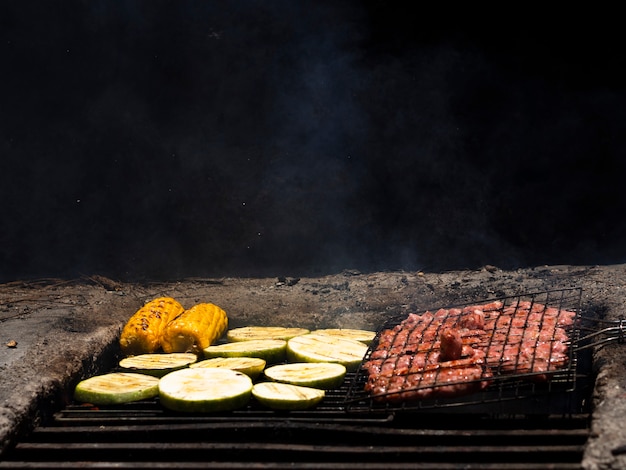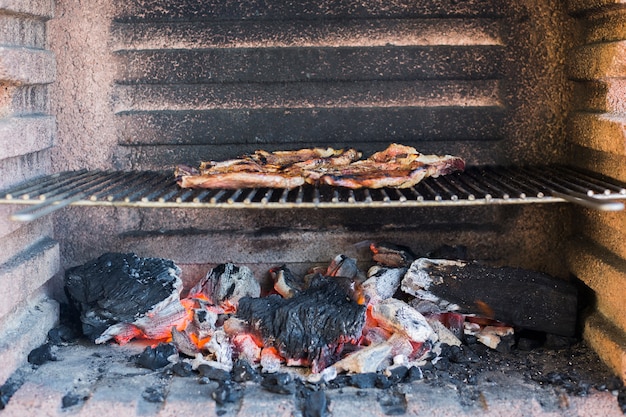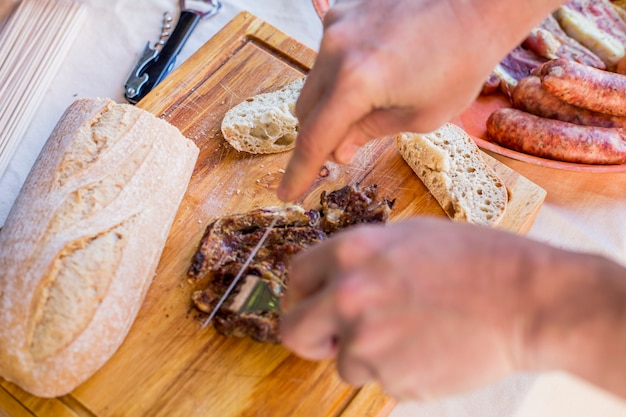(Part 1) The Perfect Pellet Grill: Your Brisket's Foundation

Choosing the Right Pellet Grill: A Match Made in BBQ Heaven
With so many pellet grills on the market, it can be overwhelming. Don't sweat it! Look for these essential features:- Temperature Control: A good pellet grill should be a steady Eddie, holding a constant temperature throughout those long cooks. Look for a digital controller and an accurate thermometer, your trusty guides in the heat of the moment.
- Size: You need enough room for your brisket and some breathing space for optimal airflow. Most brisket recipes call for a 10-12lb beast, so a grill with at least 600 square inches of cooking space is ideal.
- Fuel Capacity: A larger hopper means fewer interruptions for refilling during those marathon cooks. Aim for a hopper that can hold at least 10lbs of pellets, keeping the party going strong.
- Smoke Production: You want a grill that creates a steady stream of smoke, infusing that irresistible, smoky flavour into your brisket. Look for a grill with a dedicated smoke setting or a feature that allows you to adjust the smoke output for your desired level of smokiness.
Getting to Know Your Pellet Grill: Building a Strong Partnership
Once you've found your perfect grill, take some time to get acquainted. Experiment with different pellet flavours, learn the ins and outs of controlling the temperature, and practice maintaining a consistent smoke flow. It's like building a relationship – you need to spend time together to really understand each other.Essential Accessories: Your Brisket's Sidekicks
Just like any good team, you'll need a few essential accessories to help you along the way:- meat thermometer: This is your constant companion, a vital tool for monitoring the internal temperature of your brisket and ensuring it reaches the perfect level of doneness.
- Grill Gloves: Handling hot grates and brisket requires a little protection. Invest in a good pair of heat-resistant gloves, saving your hands from burns and ensuring a comfortable cook.
- Grill Cleaning Tools: Keeping your grill clean is crucial for consistent performance and optimal flavour. Invest in a good grill brush, scraper, and a grease tray to keep things tidy and running smoothly.
- Brisket Injection: (More on this later!)
- Butcher Paper: A true brisket hero, butcher paper plays a vital role in the "texas crutch" phase (more on that later), creating a moist, steamy environment that helps the brisket cook evenly and tenderize those tough muscle fibers.
(Part 2) The Brisket: Choosing, Preparing, and Trimming – A Culinary Symphony

Picking the perfect brisket: The Star of the Show
Head to your butcher or supermarket and ask for a "packer" brisket. This cut, usually larger than its counterpart, the "flat," comes with a natural fat cap, a vital ingredient for flavor and moisture. Look for a brisket with a good amount of marbling, the fat streaks running through the muscle, promising an incredibly flavorful experience.Preparing Your Brisket: A Clean Slate for Flavor
Once you've brought your perfect brisket home, it's time to give it a good clean-up. First, rinse it thoroughly with cold water, removing any excess fat or debris. Now, let's talk about trimming that fat cap. Don't go overboard! You want to leave a good layer of fat on top, acting as a natural insulator and flavor enhancer, but you want to remove any thick chunks that might impede even cooking.Trimming Tips: A Balanced Approach
Think of the fat cap as a cozy blanket for your brisket. It's the key to keeping the meat moist and juicy. Aim to leave about a quarter-inch layer of fat on top, trimming any excess fat that's hanging off the sides. Use a sharp knife and cut along the lines of fat, avoiding tearing the meat and preserving its integrity.Rub Down and Injection (Optional): Adding Your Personal Touch
Alright, now for the fun part: the rub! This is where your creativity and personal preference shine through. Here's my go-to brisket rub, a symphony of flavors:- 1 tablespoon smoked paprika
- 1 tablespoon garlic powder
- 1 tablespoon onion powder
- 1 tablespoon brown sugar
- 1 tablespoon kosher salt
- 1 teaspoon black pepper
- 1 teaspoon chili powder
(Part 3) The Cook: Setting Up and Maintaining Temperature – The Dance of Heat and Smoke

Setting Up Your Pellet Grill: The Stage is Set
Start by cleaning your grill grates, making sure they're sparkling clean, and adding a good layer of pellets. I prefer a blend of hickory and pecan, creating a balanced, smoky flavor that complements the brisket beautifully. Preheat your grill to 225 degrees Fahrenheit (107 degrees Celsius) – our magic number for brisket, a temperature that allows the meat to cook slowly, rendering the fat and achieving that melt-in-your-mouth tenderness.The First Stage: Smoking – The Initial Embrace
Once your grill is at temperature, place your brisket on the grate, fat cap facing up, allowing the smoke to envelop it. Now, close the lid and let it smoke for about 6 hours. Resist the temptation to peek too often, maintain that steady, even temperature and smoke flow, letting the magic happen.The Second Stage: The "Texas Crutch" – A Triumphant Turn
After those initial 6 hours, it's time for a game-changer, a technique that elevates your brisket to new heights: the "Texas Crutch." This involves wrapping your brisket in butcher paper, creating a moist, steamy environment that encourages even cooking, tenderizing those tough muscle fibers and maximizing juiciness.Wrapping Your Brisket: A Warm Embrace
Open your grill and carefully remove your brisket. Wrap it tightly in butcher paper, sealing the edges with a little bit of water, creating a cocoon of moisture. Place it back on the grill, fat side up. Now, gently increase the temperature to 250 degrees Fahrenheit (121 degrees Celsius) for the next 4-5 hours, continuing the cook while allowing the moisture to work its magic.(Part 4) The Stall: Understanding the "Plateau" – A Pause in the Journey
Ah, the brisket stall, a rite of passage for every brisket smoker, a moment that can test your patience. It's a period during the cook where the brisket's internal temperature stops rising, seemingly stuck in a plateau.Why Does the Stall Happen? A Matter of Evaporation
The stall occurs as the moisture evaporates from the brisket, slowing down the cooking process. Don't panic! It's a natural part of the brisket cook, a brief pause in the grand scheme of things.How to Handle the Stall: Patience and Persistance
The key is to remain calm and patient. Keep the grill temperature consistent, and resist the urge to open the lid unless absolutely necessary. It might feel like nothing is happening, but the brisket is still cooking, becoming more tender with each passing minute. Think of it as a slow burn, a gradual transformation that will be worth the wait.(Part 5) Checking for Doneness: The "Poke Test" and Internal Temperature – A Symphony of Indicators
After those initial 10-11 hours, it's time to start checking for doneness. This is a pivotal moment, and you have a few tools at your disposal to ensure your brisket is cooked to perfection.The "Poke Test" – A Gentle Touch
This is a good visual indicator of doneness. Using a fork, gently poke the brisket. If it offers little resistance, feeling like it's "giving" a bit, it's a good sign that it's nearing the end of its journey.The Internal Temperature – A Precise Gauge
The most reliable method for determining doneness is with a meat thermometer. Aim for an internal temperature of 203-205 degrees Fahrenheit (95-96 degrees Celsius), a temperature that signals the brisket is cooked through and ready for its grand finale.The Rest: Patience is Key – A Moment of Reflection
Once you've reached that desired internal temperature, it's time for the final stage: the rest. This is a crucial step that allows the brisket to reabsorb its juices and tenderize further, achieving that melt-in-your-mouth texture. Wrap your brisket back up in the butcher paper and let it rest for at least 2 hours, allowing the flavors to meld and the juices to redistribute.(Part 6) Slicing and Serving: Unveiling the Brisket – The Grand Finale
After that long wait, the moment of truth has arrived. It's time to unveil the brisket and experience the culmination of your efforts.Slicing the Brisket: A Culinary Masterpiece
First, remove your brisket from the butcher paper and let it cool slightly. Now, using a sharp knife, slice it against the grain. This means slicing perpendicular to the muscle fibres, resulting in tender, melt-in-your-mouth slices, a testament to your patience and skill.Serving Your Brisket: A Feast for the Senses
Now, you can serve your brisket however your heart desires. Create a classic brisket sandwich with some tangy pickles and crisp onions, or elevate it with a side of creamy mac and cheese or savory baked beans. The possibilities are endless, allowing you to personalize your culinary creation.(Part 7) Mastering the Basics: Variations and Experimentation – A World of FlavorYou've conquered the basics, but don't be afraid to unleash your inner culinary artist! There's a whole world of flavor waiting to be explored.Adding Flavor with Wood: A Symphony of Smoke
Experiment with different wood types to create unique smoky flavors. Maple, cherry, and oak are popular choices, each adding a distinct note to the overall flavor profile. You can even create custom blends, combining wood types for a more complex and nuanced flavor experience.Injecting Brisket: A Secret Weapon for Moisture
Injecting your brisket can add an extra layer of flavor and moisture, taking it to new heights. You can use a simple beef broth injection, a classic that enhances the inherent flavors of the meat. Or get creative with garlic, Worcestershire sauce, or even a splash of apple juice, customizing the flavor profile to your liking.Sauces and Rubs: The Finishing Touches
Don't be afraid to explore different rubs and sauces, adding your personal touch to the final result. You can find pre-made options at your local grocery store, or unleash your creativity and create your own custom blends, a unique signature for your brisket masterpieces. (Part 8) FAQs: Common Brisket Questions – A Guide to Success
You've reached the end of this epic journey, armed with the knowledge to create brisket perfection. But before you fire up your grill, let's tackle some common questions about brisket, ensuring you're prepared for every step of the way.FAQs:
Q1: How long does it take to cook a brisket?
The cooking time for a brisket varies depending on its size and the method you use. A typical 10-12lb brisket takes around 10-12 hours on a pellet grill, a testament to the slow and steady nature of this culinary adventure.
Q2: What temperature should I cook brisket at?
A low and slow cook at 225-250 degrees Fahrenheit (107-121 degrees Celsius) is ideal for brisket, allowing the meat to cook gently, rendering the fat and achieving that melt-in-your-mouth tenderness.
Q3: Can I overcook brisket?
It's possible to overcook a brisket, especially if you're not using a thermometer. An overcooked brisket will be dry and tough. Aim for an internal temperature of 203-205 degrees Fahrenheit (95-96 degrees Celsius) and then let it rest to ensure a perfect outcome.
Q4: What are the best side dishes for brisket?
Brisket pairs well with a variety of side dishes, including creamy mac and cheese, baked beans, coleslaw, potato salad, and cornbread, creating a balanced and satisfying meal. Choose sides that complement the smoky flavor of the brisket, enhancing the overall dining experience.
Q5: How do I know when the brisket is done?
A combination of the "poke test" and internal temperature is the most reliable way to determine if your brisket is done. When you poke it, it should feel tender and offer little resistance. The internal temperature should reach 203-205 degrees Fahrenheit (95-96 degrees Celsius), signaling that the brisket is perfectly cooked.
There you have it, friends! Your ultimate guide to brisket perfection on a pellet grill. Now go forth and conquer, and remember, patience is your ally in this culinary adventure. With a little practice and a dash of creativity, you'll be turning out mouthwatering brisket like a pro, delighting your taste buds and impressing your guests. Happy grilling!Everyone is watching

Perfect Rice Every Time: The Ultimate Guide to Cooking Rice
Cooking TipsAs a self-proclaimed foodie, I've always been a bit obsessed with rice. It's the foundation of countless cuisi...

Prime Rib Roast Cooking Time Chart: Per Pound Guide
Cooking TipsPrime rib roast. Just the name conjures images of lavish dinners, crackling fires, and hearty laughter. It’s ...

The Ultimate Guide to Cooking Asparagus: Tips, Techniques, and Recipes
Cooking TipsAsparagus. The mere mention of this spring delicacy conjures up images of vibrant green spears, crisp and burs...

Ultimate Guide to Cooking the Perfect Thanksgiving Turkey
Cooking TipsThanksgiving. Just the word conjures up images of overflowing tables laden with delicious food, the scent of r...

How Long to Bake Potatoes in the Oven (Perfect Every Time)
Cooking TipsBaked potatoes are a staple in my kitchen. They're incredibly versatile, delicious, and surprisingly easy to m...
